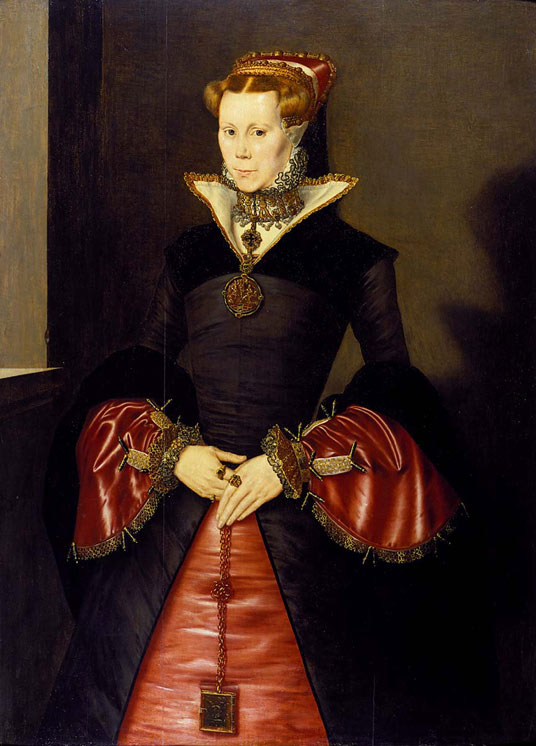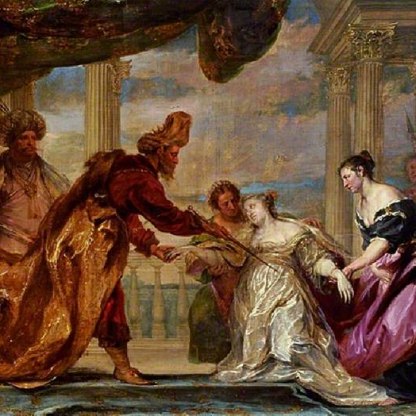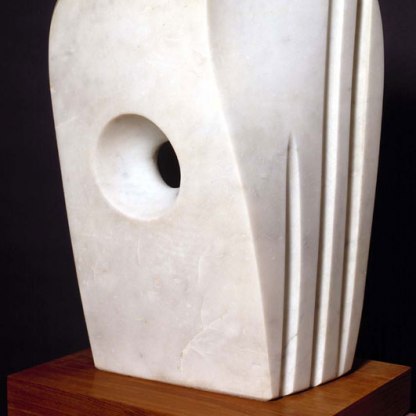Mary Tudor

This painting does not bear a date, but the style of the sitter’s clothes suggests that it was made in or around 1553. The woman's face is so close to other known portraits of Mary Tudor by Hans Eworth, such as that, left, from the Royal Society of Antiquaries, London, that an identification with the recently crowned queen is more than reasonable. This sitter is perhaps younger than one might have expected Mary to have looked in 1553, but otherwise her features and her slight physique accord with contemporary written descriptions of the queen.
Mary may not have shared the physical bulk of her father Henry VIII, or subscribed to his brand of Reformed Christanity, but she did inherit his love of personal adornment and display. As one foreign ambassador wrote,
She makes great use of Jewels ... and although she has plenty of them ... yet were she better supplied with money than she is, she would doubtless buy many more ...
There is a sombre, rather than ostentatious tone to this painting, and yet Mary is richly attired, and her jewels, if discreet, are nonetheless magnificent. Just below the black and gold cross at her neck, a large brooch stands out against the black satin of her bodice. A scene depicted upon it in relief can just be discerned. It shows the Old Testament Queen Esther interceding with her husband, the pagan King Ahasuerus, on behalf of her fellow Jews. Christians interpreted this Old Testament royal heroine as a prefiguration of the Virgin Mary as Queen of Heaven. The relevance of the story to the recently crowned Queen Mary of England is clear.
The square object hanging from a chain around Mary’s waist is a tablett or girdle-book, a popular form of jewellery among women in the Tudor court. It consisted of a book of devotions bound within a case that was usually decorated with enamel and jewels.
Three rings sit conspicuously on Mary's fingers. Mary was unmarried when she came to the throne, but was nevertheless keen to emphasise her symbolic betrothal to the state. In a speech of 1554 she asserted that her patriotism was made manifest by 'the spousal ring whereof I have on my finger, which never hitherto was, nor hereafter shall be left off ...'
Her jewels here, then, stand as emblems of her loyalty to the Catholic church and the throne of England – two institutions that had been hard to reconcile since the reign of Henry VIII.
The elegance of Mary’s outfit contrasts strangely with the dinginess of her surroundings. The drab, grey background is dimly illuminated by a window at the left which provides just enough light to cast a large, unhappy shadow of Mary on the wall behind her. Shadows had been used in portraiture before, notably in the work of Hans Holbein, but they rarely evoke so gloomy an atmosphere.
This is not the romantic, cultivated melancholy that would later characterise certain Elizabethan portraits, like that we see in a Nicholas Hilliard miniature in the Fitzwilliam [PD.3-1953]. There is a sense of real anxiety here, of isolation. Mary is vulnerable, frail-looking, surrounded by shadow in a cold, bleak room.
Ultimately it is a sympathetic image. Viewing it, one thinks less of ‘Bloody’ Mary, the merciless burner of Protestants, than of the lonely princess of the 1530s, neglected by her father, bullied by her stepmother, taking refuge in prayer and scholarship. Hans Eworth himself was a Protestant, who had moved from Antwerp to England in 1545. But his association with Mary and other Catholic aristocrats, led to his being neglected under the reign of Elizabeth I. The image of Mary here was not perhaps of the sort that Elizabeth wanted her hated half-sister to be remembered by.
Themes and periods
Data from our collections database
Francis Barchard, (d. 1856), of Horstead Place, Uckfield, Sussex, who bought it in 1854; Mrs Maude Barchard , the widow of his great-grandson; bt. from her by P. and D. Colnaghi & Co. Ltd, London; exh. Colnaghi's, 1949, when it was bought by Sir Bruce Ingram
Acquisition and important dates
- Method of acquisition: Bequeathed
- Dates: 1963
Dating
Maker(s)
- Ewouts, Hans Painter
Materials used in production
Read more about this recordStories, Contexts and Themes
Other highlight objects you might like
Suggested Curating Cambridge products
Sign up to our emails
Be the first to hear about our news, exhibitions, events and more…







